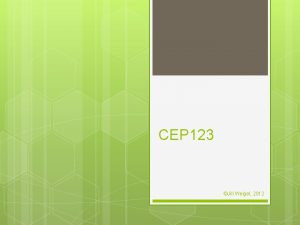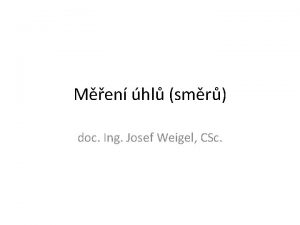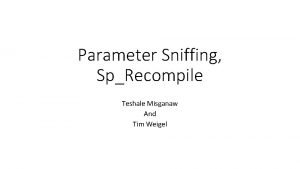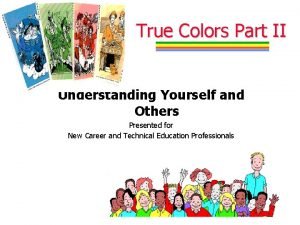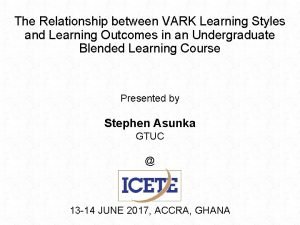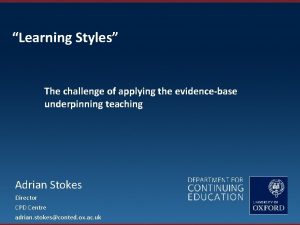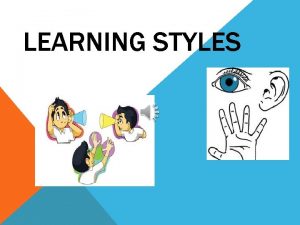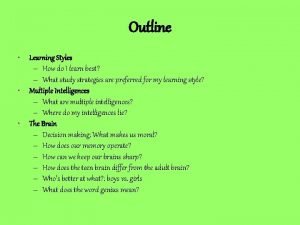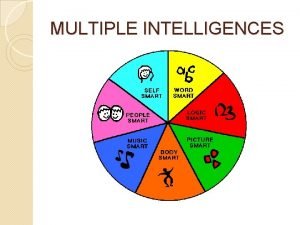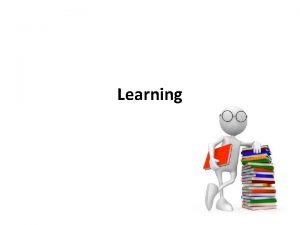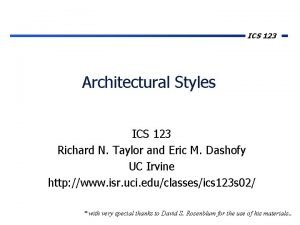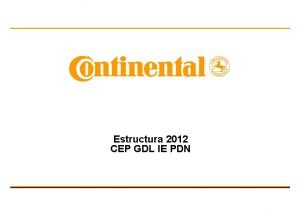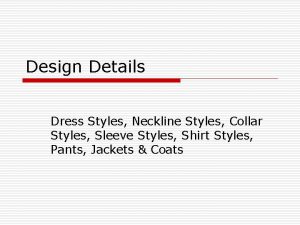CEP 123 Jill Weigel 2012 Learning Styles http










- Slides: 10

CEP 123 ©Jill Weigel, 2012

Learning Styles http: //www. vark- learn. com/english/page. asp? p=helpsheets What did you discover about yourself? How will you implement new learning strategies into your study sessions? Write down 2 strategies you will utilize in your future study plans on your weekly planner. Do them! Don’t procrastinate! Set reasonable goals Get started – even if you aren’t in the mood to do the work – start with a small goal. Then keep going once you get into the groove. ©Jill Weigel, 2012

Read/Write Study Strategies If you have a strong preference for learning by Reading and Writing (R & W) learning you should use some, or all, of the following: INTAKE To take in the information: lists headings dictionaries glossaries definitions handouts textbooks readings - library notes (often verbatim) teachers who use words well and have lots of information in sentences and notes essays manuals (computing, technical and laboratory) ©Jill Weigel, 2012

Read/Write Study Strategies To make a learnable package: Convert your "notes" into a learnable package by reducing them Write out the words again and again. Read your notes (silently) again and again. Rewrite the ideas and principles into other words. Organize any diagrams, graphs. . . into statements, e. g. "The trend is. . . " Turn reactions, diagrams, charts and flows into words. Imagine your lists arranged in multiple choice questions and distinguish each from each. OUTPUT To perform well in any test, assignment or examination: Write exam answers. Practice with multiple choice questions. Write paragraphs, beginnings and endings. Write your information into lists (a, b, c, d or 1, 2, 3, 4). Arrange your words into hierarchies and points. You like this page because the emphasis is on words and lists. You believe the meanings are within the words, so any talk is OK but this handout is better. ©Jill Weigel, 2012 You are heading for the library.

Visual Learners ©Jill Weigel, 2012

Aural Study Strategies If you have a strong preference for learning by Aural methods (A = hearing) you should use some or all of the following: INTAKE To take in the information: attend classes attend discussions and tutorials discuss topics with others discuss topics with your teachers explain new ideas to other people use a tape recorder remember the interesting examples, stories, jokes. . . describe the overheads, pictures and other visuals to somebody who was not there leave spaces in your notes for later recall and 'filling' ©Jill Weigel, 2012

Aural Study Strategies To make a learnable package: Convert your "notes" into a learnable package by reducing them Your notes may be poor because you prefer to listen. You will need to expand your notes by talking with others and collecting notes from the textbook. Put your summarized notes onto tapes and listen to them. Ask others to 'hear' your understanding of a topic. Read your summarized notes aloud. Explain your notes to another 'aural' person. OUTPUT To perform well in any test, assignment or examination: Imagine talking with the examiner. Listen to your voices and write them down. Spend time in quiet places recalling the ideas. Practice writing answers to old exam questions. Speak your answers aloud or inside your head. You prefer to have this page explained to you. The written words are not as valuable as those you hear. You will probably go and tell somebody about this. ©Jill Weigel, 2012

Kinesthetic Study Strategies If you have a strong Kinesthetic preference for learning you should use some or all of the following: INTAKE To take in the information: all your senses - sight, touch, taste, smell, hearing. . . laboratories field trips field tours examples of principles lecturers who give real-life examples applications hands-on approaches (computing) trial and error collections of rock types, plants, shells, grasses. . . exhibits, samples, photographs. . . ©Jill Weigel, 2012 recipes - solutions to problems, previous exam papers

Kinesthetic Study Strategies To make a learnable package: Convert your "notes" into a learnable package by reducing them Your lecture notes may be poor because the topics were not 'concrete' or 'relevant'. You will remember the "real" things that happened. Put plenty of examples into your summary. Use case studies and applications to help with principles and abstract concepts. Talk about your notes with another "K" person. Use pictures and photographs that illustrate an idea. Go back to the laboratory or your lab manual. Recall the experiments, field trip. . . Incorporate physical movement into your study sessions (sit on an exercise ball, lift weights, squeeze a stress ball…) OUTPUT To perform well in any test, assignment or examination: Write practice answers, paragraphs. . . Role play the exam situation in your own room. You want to experience the exam so that you can understand it. The ideas on this page are only valuable if they sound practical, real, and ©Jill Weigel, 2012 relevant to you. You need to do things to understand.

Multimodal Study Strategies If you have multiple preferences you are in the majority, as approximately 60% of any population fits that category. You will need to read two or three or four lists of strategies provided Power. Points. If you have two almost equal preferences please read the study strategies that apply to both preferences. If you have three preferences read the three lists that apply and similarly for those with four. There is obviously no Multimodal helpsheet. One interesting piece of information that people with multimodal preferences have told us, is that it is often necessary for them to use more than one strategy for learning and communicating. They feel insecure with only one. Alternatively those with a single preference often "get it" by using the set of strategies that align with that single preference ©Jill Weigel, 2012
